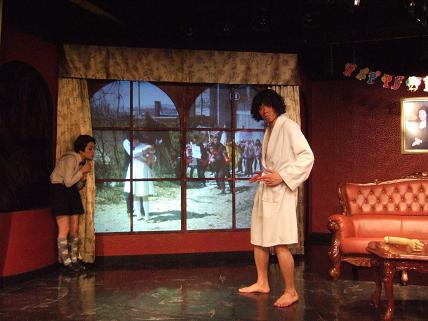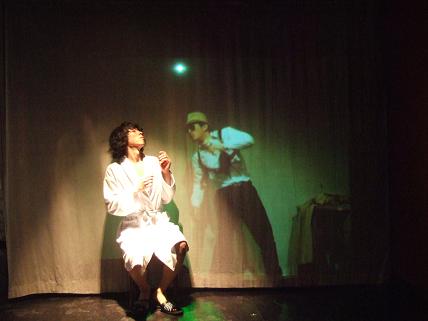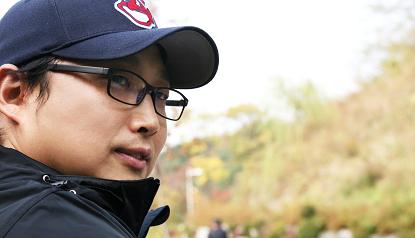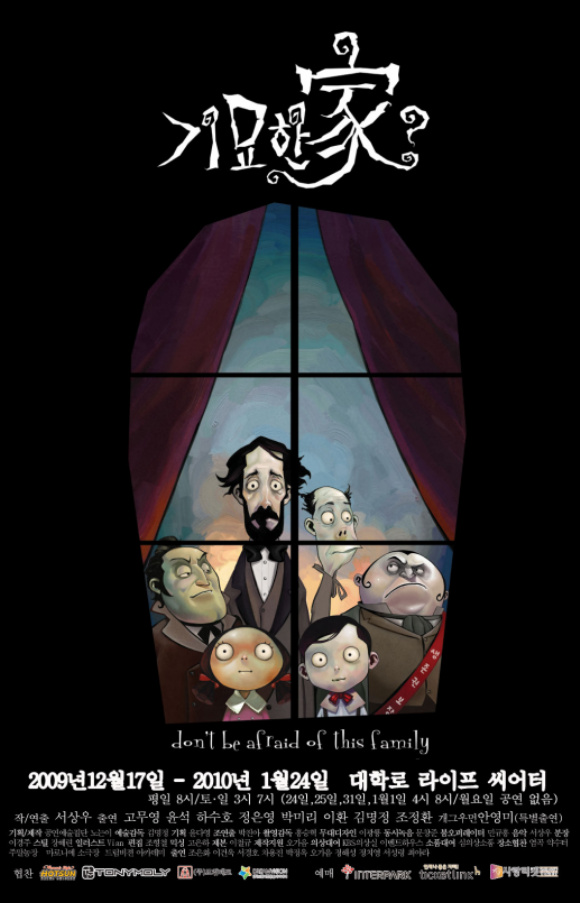A look into the home of the weird family
IN EVERYDAY conversations, many people use the word “wrong” when they mean “different.” This may appear to be a casual mistake, but what if people really fail to tell the difference between what is different and what is wrong? The inability or unwillingness to distinguish the two, whether intentionally or unintentionally, can lead to prejudice and discrimination against those who belong to the “different” category in our society. The play Don’t be Afraid of This Family shows how some innocent individuals are being victimized by our narrow-mindedness, being labeled as “monsters.”
A story of the outcasts
Strangers keep yelling outside, but a middle-aged man and two children, slightly odd-looking, just repeat the same dance routine so as to shake off the grief and worries. The hunch-backed father, a scientist, and his children Suri and Tori, the fraternal twins, are constantly being threatened and told to leave the town by a group of demonstrators, since their presence is keeping the value of houses in the area from rising. Kimyohan (meaning “weird” in Korean), another main character in the play, is an escapee from prison who is said to be responsible for innumerable crimes. The story unfolds as Kimyohan, just out of prison, ends up at the family’s door by chance. As the family and Kimyohan get to know each other, the truth behind the frightening reports about Kimyohan is unveiled. The family and the audience learn that he was branded as a brutal criminal even though he did not commit a single crime.
Although perceived as horrible and dangerous creatures by the society, the family and Kimyohan are in fact genuine and tender-hearted people. Their feelings get hurt every time the demonstrators scream cruel and groundless things about them, yet they do not blame the people but rather try to understand them. “It’s okay, because we are used to being insulted. People are afraid of accepting something new,” Tori says repeatedly throughout the play. Such remarks by this young child reflect a sad truth about our society. In a society hostile towards anything that deviates from its “standard,” many minorities, feeling powerless as they face prejudice and unfair treatment, cannot help but accept the injustice done to them.

Beyond the stage
A big screen, picture frames in motion, and a TV on the side wall: Looking at the unusual stage set, the audience might notice that the way this play delivers its story is out of the ordinary. Don’t be Afraid of This Family is considered to be a work of mixed media, for it integrates film and performing art to present the story more effectively and realistically to the audience. Throughout the play, the stage shows only the inside of the family’s house, but there is a big screen on the stage that literally serves as the house’s window, through which the actors and the audience can see the outside. Along with the acting on stage, a movie is projected on the screen, showing what is happening outside at the particular moment. The scene in which Kimyohan recalls himself being beaten by the police officer during an interrogation is particularly striking. He acts alone in front of a curtain that projects an image of everything in the interrogation room except Kimyohan himself. The police officer’s actions are pre-filmed, but Kimyohan’s performance is so real that it seems almost as if the two are acting together simultaneously. By successfully bringing out the interactions between the actors on stage and those on screen, the play overcomes the limits of stage presentation. Seo Sang-woo (Director) comments, “Some might argue that plays are supposed to leave some space for imagination, but the crew and I grafted the techniques of a movie onto this play, wanting to ‘show’ more things to the audience.” There have been plays that used movie screens as the background, but Don’t be Afraid of This Family is the first to have actors cross-act between the stage and the screen.


Are we the offenders?
There are many plays that encourage audience participation, but Don’t be Afraid of This Family takes this a step further. It integrates the audience into the plot by having them serve as town residents. When the audience enters the venue, an actor, later to be identified as the demonstration leader, starts to toss out questions like “How is your flower shop doing lately?” and “Isn’t our neighborhood just so beautiful in the summer?” as if he knows them. He further demands that everyone shout out with him, “Let us kick out the hunchbacked monsters!” The audience members are taken aback by such unexpected questions and requests, but later realize that the play had already begun at the point, and they too were actors in it. Later in the play, some are even asked to take on the roles of the claimed victims by reading the cue cards, testifying to the police officer that the family had committed horrible crimes against them.
Promoting active participation among the audience members helps to keep them entertained and gives them the chance to feel the message of the performance for themselves. Throughout the play, the audience witnesses that those whom they called “monsters” in the beginning are actually innocent and warm-hearted people, and as “normal” as they are. But when asked to give false testimonies against these people, they agree to do so even though they feel uncomfortable with the injustice of the situation. When the audience members realize that they unjustly helped bring misfortune to the family, the feeling of guilt leads them to reflect upon their actions in real life.
* * *
People know in their heads that being different is not something to be ashamed of; being intolerant is. But it often seems that it is not so easy for them to know this in their hearts. Don’t be Afraid of This Family attempts to illustrate this issue, yet not in the didactic manner that one might expect. The open ending of the play leaves the audience with the freedom and the will to construct their own thoughts on the issue. In addition, the element of humor, although not strong enough to shake the audience with laughter, keeps them light-hearted throughout the play despite its rather grave theme.
Box 1
Interview with Seo Sang-woo (Writer/Director)

What is the significance of the fact that some characters appear hunchbacked?
The hunchedness is a feature that symbolizes how the family members are a bit different from other townspeople. What I hope the audience would notice is that beside the fact that they are hunchbacked, they do not demonstrate any physical abnormality, let alone a mental one. The townspeople in the play call them monsters, but the audience can see that they are not all that different from other people. Likewise, some people in our society might look a little different on the outside, but are essentially the same people as we are, which is what I intended to communicate to the audience.
Box 2

Title: Don’t be Afraid of This Family
Genre: Play
Place: Daehangno, The Life Theater
Running Date: Open run
Price: 12,000 Tue-Fri, 15,000 Sat-Sun

